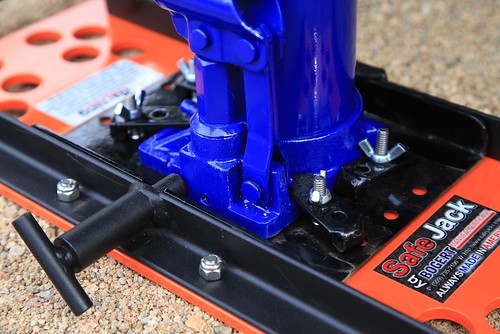
I suspect Richard Bogert is one of those people who keeps a notepad and pen on the nightstand, so he can jot down inspirations that pop into his head at 3:00 a.m. I can’t see any other way he could come up with the volume of ideas he does—for the Bogert Aviation arm of his business, the military equipment, odds and ends such as high-quality bed frames, and the more recent foray into products suitable for overland travelers and four-wheel-drive vehicle owners in general.
I’ve written about Bogert’s Safe Jack system for the Hi-Lift jack (here), which transforms the Hi-Lift from a versatile but at times unstable lifting device into a rock-solid lifting device. Recently Richard shipped me a new suite of Safe Jack products that accomplishes similar wonders for the ubiquitous bottle jack.
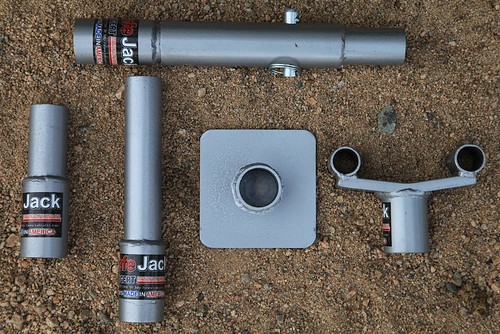
Bottle jacks have several advantages over the Hi-Lift (or other beam-type jacks). They’re powerful for their compact size and weight, are physically much easier to operate given the hydraulic assist (with no danger of kick-back), and come in a wide range of lifting capacity. They’re significantly easier to use for tire-changing or inserting sand mats, since (sometimes with some excavating) one can place them under an axle and lift one wheel directly. To use a four-foot-long, 30-pound Hi-Lift in the same situation one must either lift the bumper—which requires lifting through the entire suspension travel as well before the wheel rises—or employ a Lift-Mate which attaches to the wheel, suitable for inserting sand mats but useless for tire-changing.
But bottle jacks have downsides too, and salient among them is the short lifting range—about six inches compared with thirty six for even the shortest Hi-Lift. Even double-extension bottle jacks (such as the excellent Italian-made Land Rover axle jacks, or the equally excellent German-made Power Team jack I own) top out at around a foot of lift. So if, for example, one needs to jack up a chassis member that sits 18 inches off the ground, and you’re using my eight-inch-tall double-extension bottle jack with a 12-inch lift, by the time the piston reaches the chassis you’ve got two inches of jacking function left. We all know what comes next: a makeshift platform of 2x4s, rocks, or worse to get the jack closer to the chassis. Screw extensions on the piston help but don’t solve the problem.
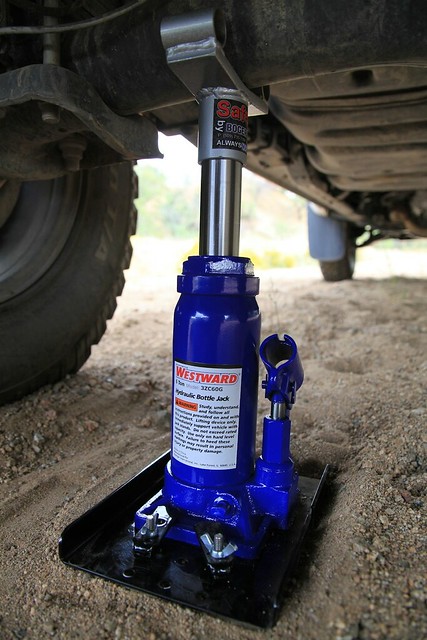 A universal base plate and axle cradle vastly enhance the stability of a standard bottle jack.
A universal base plate and axle cradle vastly enhance the stability of a standard bottle jack.
Richard solved it. The Bogert Bottle Jack Recovery Kit includes three extensions that slip securely over the typical 1 1/4-inch-diameter bottle-jack piston. One provides 2 1/2 inches of extension, another 5 1/2, and a third is adjustable from 8 to 12 inches. Stack them and you could theoretically lift against something 31 inches high with that eight-inch-tall jack still firmly on the ground. The kit also includes a plate to spread out the stress of the jack’s piston against a frame member or skid plate, and an axle cradle that hugely increases the stability of the jack under an axle tube. It all comes in a stout Husky zippered carrying bag big enough to also hold the (optional) bottle jack.
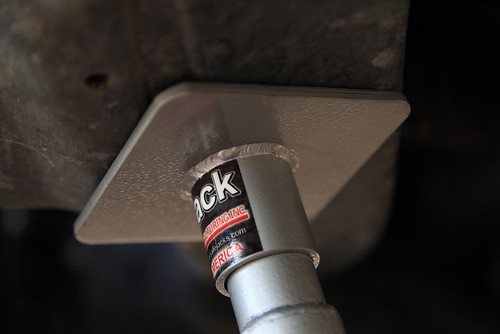 This plate disperses the stress of lifting on skid plates or a thin-gauge Land Rover chassis.
This plate disperses the stress of lifting on skid plates or a thin-gauge Land Rover chassis.
There’s more to the a la carte system. A universal base plate fits most bottle jacks up to 20 tons, and provides 48 square inches of surface area for stability and flotation in soft substrate—significantly greater than the 28 square inches of a Hi-Lift’s standard base plate. Not enough? The universal base plate with jack attached snaps instantly into Bogert’s twin-handled ”Big Foot” base plate, which covers a full 144 square inches of the earth’s surface, exactly the same as the common orange ORB Hi-Lift base plate (or Bogert’s own Safe Jack base plate for the Hi-Lift). If you’re lifting 3,000 pounds that would reduce the 200 pounds per square inch loading under a naked bottle jack to just over 20. The handles make it easy to scoot the jack into and out of spots under the vehicle.
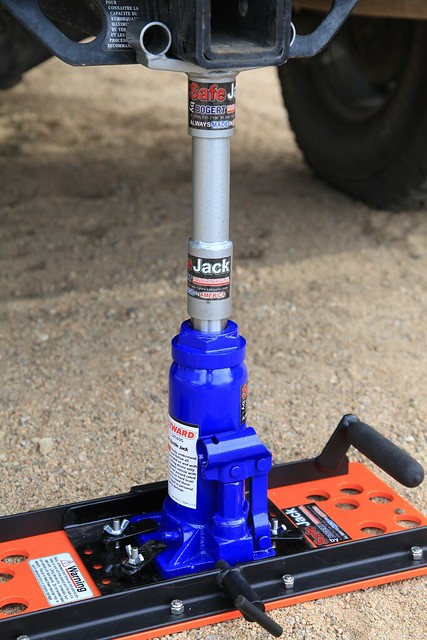 With an extension and the cradle I was able to securely lift the back of the truck at the receiver hitch.
With an extension and the cradle I was able to securely lift the back of the truck at the receiver hitch.
The recovery kit enhances the versatility of any bottle jack, making it easier to use the jack to apply pressure wherever it might be needed—straightening a bent tie rod or bumper, fractionally raising an engine to replace a broken motor mount, or pushing on a roof rack to ease a vehicle away from a rock it has slid into sideways.
One complaint—more of a suggestion really: Bogert Manufacturing’s red-white-and-blue “Always made in America” stickers are plastered on each and every piece in the Safe Jack system—fine, except that one is also plastered on the made-in-China bottle jack if you order that option. I’d urge Richard to either leave the tag off the jack, or (better) find an American-made bottle jack. That nitpick aside, this is another imaginative and useful product from Richard Bogert’s bedside notepad. Bogert Manufacturing is here.
(Edit: Richard says the stickers are no longer applied to the jack. Do U.S.-made bottle jacks even exist any more?)
